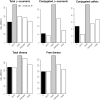Phenolic content variability and its chromosome location in tritordeum
- PMID: 24523725
- PMCID: PMC3906567
- DOI: 10.3389/fpls.2014.00010
Phenolic content variability and its chromosome location in tritordeum
Abstract
For humans, wheat is the most important source of calories, but it is also a source of antioxidant compounds that are involved in the prevention of chronic disease. Among the antioxidant compounds, phenolic acids have great potential to improve human health. In this paper we evaluate the effect of environmental and genetic factors on the phenolics content in the grain of a collection of tritordeums with different cytoplasm and chromosome substitutions. To this purpose, tritordeum flour was used for extraction of the free, conjugates and bound phenolic compounds. These phenolic compounds were identified and quantified by RP-HPLC and the results were analyzed by univariate and multivariate methods. This is the first study that describes the composition of phenolic acids of the amphiploid tritordeum. As in wheat, the predominant phenolic compound is ferulic acid. In tritordeum there is great variability for the content of phenolic compounds and the main factor which determines its content is the genotype followed by the environment, in this case included in the year factor. Phenolic acid content is associated with the substitution of chromosome DS1D(1H(ch)) and DS2D(2H(ch)), and the translocation 1RS/1BL in tritordeum. The results show that there is high potential for further improving the quality and quantity of phenolics in tritordeum because this amphiploid shows high variability for the content of phenolic compounds.
Keywords: antioxidant; chromosome sustitution; flour quality; healthy; nutritive; plant breeding; variability; wheat.
Figures




Similar articles
-
Tritordeum: Creating a New Crop Species-The Successful Use of Plant Genetic Resources.Plants (Basel). 2021 May 20;10(5):1029. doi: 10.3390/plants10051029. Plants (Basel). 2021. PMID: 34065483 Free PMC article. Review.
-
Influence of Agronomic Practices on the Antioxidant Compounds of Pigmented Wheat (Triticum aestivum spp. aestivum L.) and Tritordeum (× Tritordeum martinii A. Pujadas, nothosp. nov.) Genotypes.J Agric Food Chem. 2023 Sep 13;71(36):13220-13233. doi: 10.1021/acs.jafc.3c02592. Epub 2023 Aug 29. J Agric Food Chem. 2023. PMID: 37641979 Free PMC article.
-
High-throughput genotyping of wheat-barley amphiploids utilising diversity array technology (DArT).BMC Plant Biol. 2013 Jun 3;13:87. doi: 10.1186/1471-2229-13-87. BMC Plant Biol. 2013. PMID: 23725040 Free PMC article.
-
Distribution of bioactive compounds in pearled fractions of tritordeum.Food Chem. 2019 Dec 15;301:125228. doi: 10.1016/j.foodchem.2019.125228. Epub 2019 Jul 23. Food Chem. 2019. PMID: 31377613
-
Wheat grain phenolics: a review on composition, bioactivity, and influencing factors.J Sci Food Agric. 2021 Dec;101(15):6167-6185. doi: 10.1002/jsfa.11428. Epub 2021 Aug 12. J Sci Food Agric. 2021. PMID: 34312865 Review.
Cited by
-
Genomic restructuring in F1 Hordeum chilense × durum wheat hybrids and corresponding hexaploid tritordeum lines revealed by DNA fingerprinting analyses.J Genet. 2017 Jun 26;96(2):e13-e23. doi: 10.1007/s12041-017-0772-0. J Genet. 2017. PMID: 28674217 No abstract available.
-
Tritordeum: Creating a New Crop Species-The Successful Use of Plant Genetic Resources.Plants (Basel). 2021 May 20;10(5):1029. doi: 10.3390/plants10051029. Plants (Basel). 2021. PMID: 34065483 Free PMC article. Review.
-
Evaluation of Phenolic Content Variability along with Antioxidant, Antimicrobial, and Cytotoxic Potential of Selected Traditional Medicinal Plants from India.Front Plant Sci. 2016 Mar 31;7:407. doi: 10.3389/fpls.2016.00407. eCollection 2016. Front Plant Sci. 2016. PMID: 27066046 Free PMC article.
-
Influence of Agronomic Practices on the Antioxidant Compounds of Pigmented Wheat (Triticum aestivum spp. aestivum L.) and Tritordeum (× Tritordeum martinii A. Pujadas, nothosp. nov.) Genotypes.J Agric Food Chem. 2023 Sep 13;71(36):13220-13233. doi: 10.1021/acs.jafc.3c02592. Epub 2023 Aug 29. J Agric Food Chem. 2023. PMID: 37641979 Free PMC article.
-
Dietary luteolin attenuates chronic liver injury induced by mercuric chloride via the Nrf2/NF-κB/P53 signaling pathway in rats.Oncotarget. 2017 Jun 20;8(25):40982-40993. doi: 10.18632/oncotarget.17334. Oncotarget. 2017. PMID: 28498799 Free PMC article.
References
-
- Beta T., Nam S., Dexter J. E., Sapirstein H. D. (2005). Phenolic content and antioxidant activity of pearled wheat and roller-milled fractions. Cereal Chem. 82, 390–393 10.1094/CC-82-0390 - DOI
LinkOut - more resources
Full Text Sources
Other Literature Sources
Research Materials

